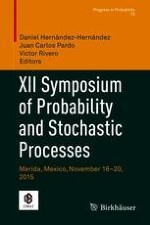This volume contains the proceedings of the XII Symposium of Probability and Stochastic Processes which took place at Universidad Autonoma de Yucatan in Merida, Mexico, on November 16–20, 2015. This meeting was the twelfth meeting in a series of ongoing biannual meetings aimed at showcasing the research of Mexican probabilists as well as promote new collaborations between the participants.
The book features articles drawn from different research areas in probability and stochastic processes, such as: risk theory, limit theorems, stochastic partial differential equations, random trees, stochastic differential games, stochastic control, and coalescence. Two of the main manuscripts survey recent developments on stochastic control and scaling limits of Markov-branching trees, written by Kazutoshi Yamasaki and Bénédicte Haas, respectively. The research-oriented manuscripts provide new advances in active research fields in Mexico.
The wide selection of topics makes the book accessible to advanced graduate students and researchers in probability and stochastic processes.
